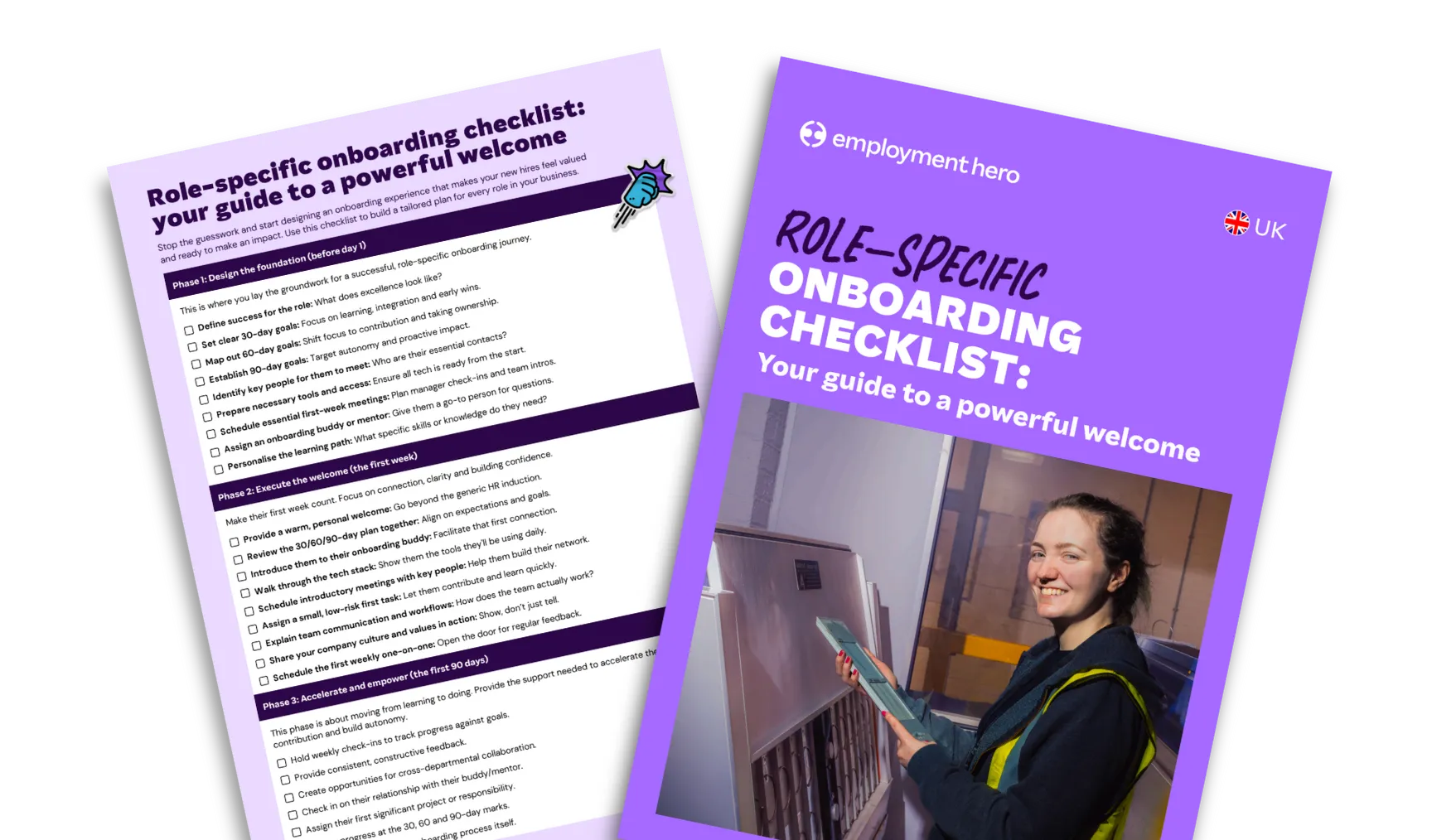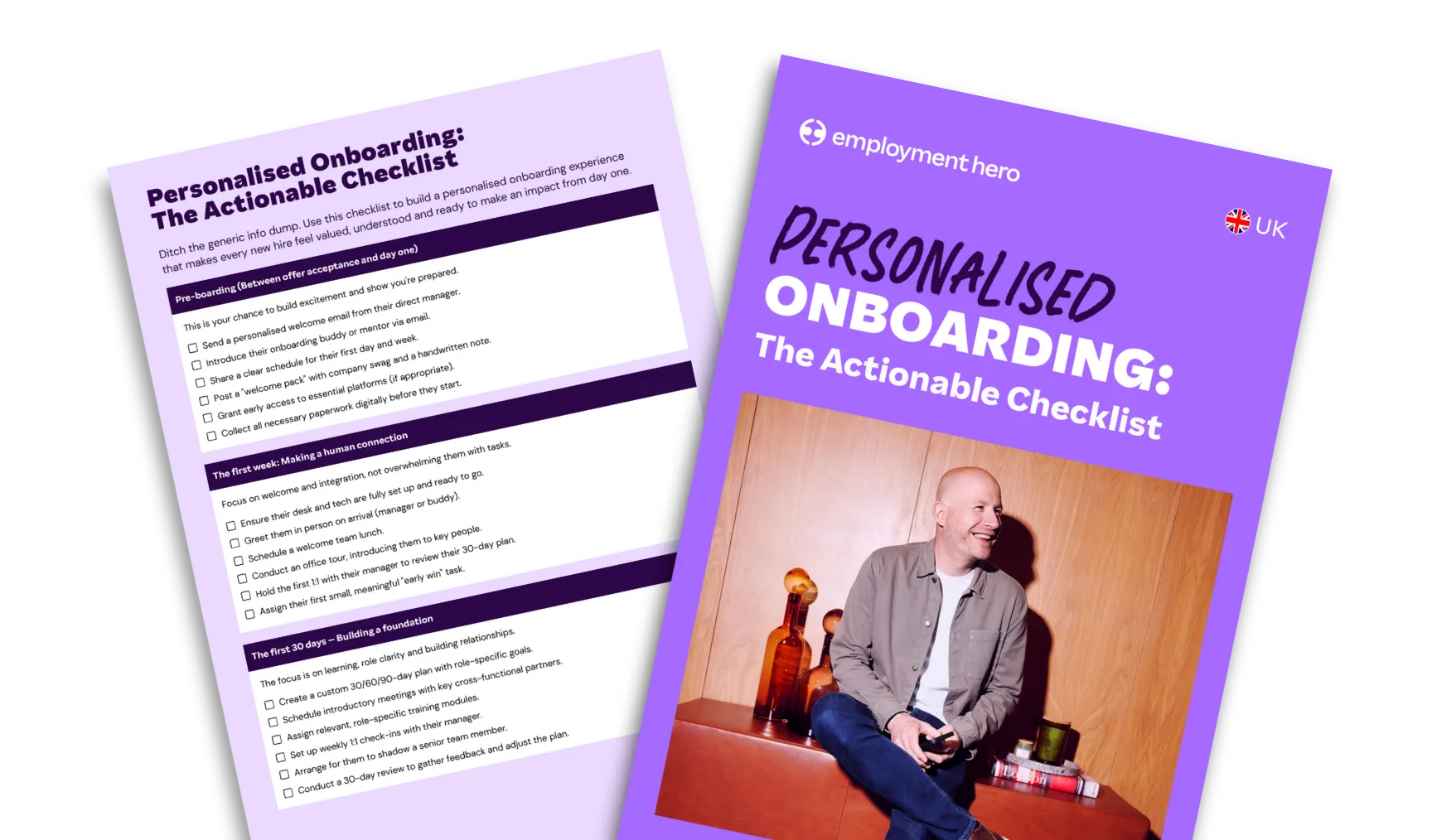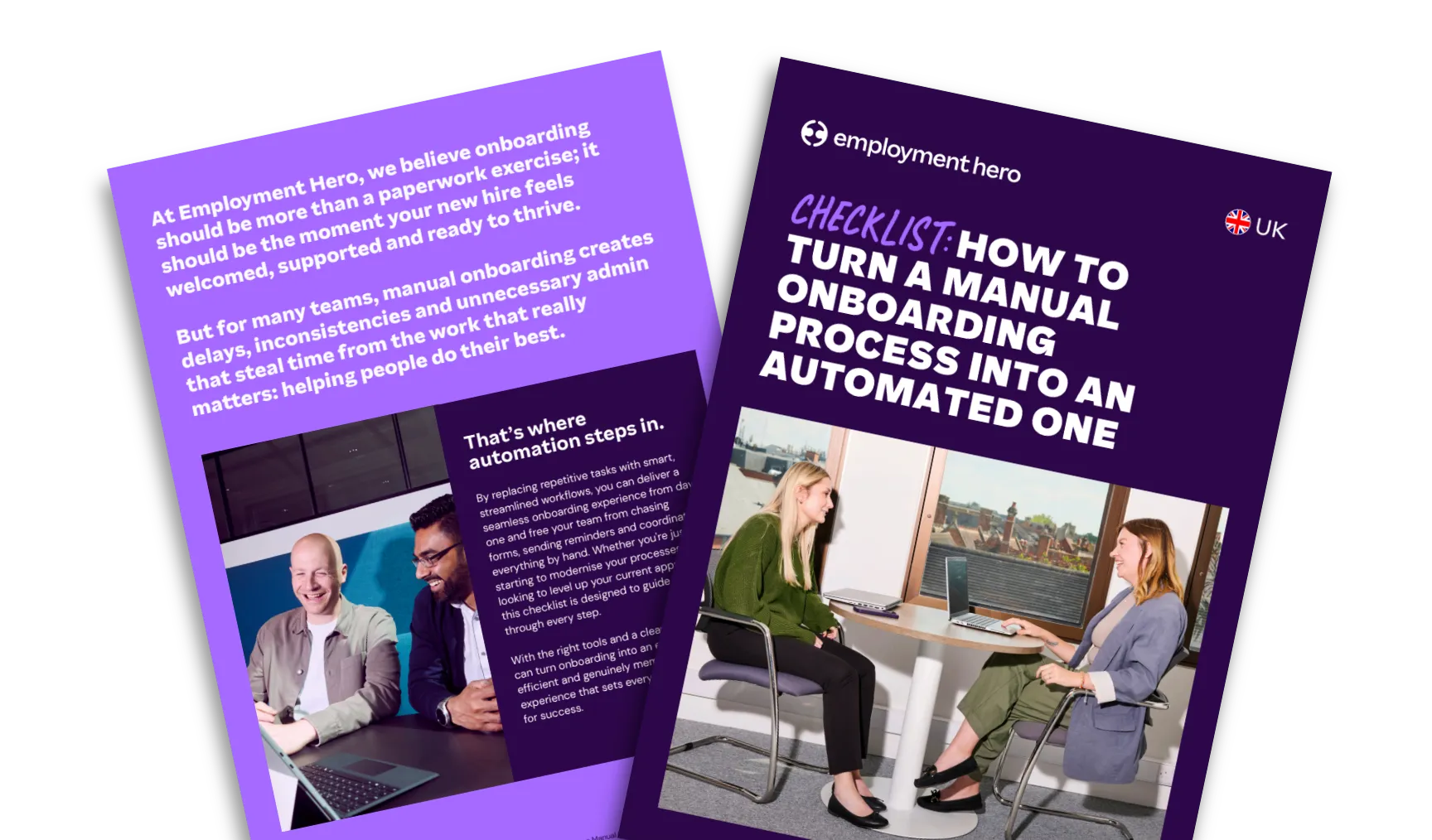Auto-Enrolment: An Employer’s Guide To Pension Submissions
Published
Auto-Enrolment: An Employer’s Guide To Pension Submissions
Published
1 min read
Understanding Auto-enrolment
Auto-enrolment is a legal requirement in the UK that employers must adhere to in order to enrol eligible workers into a workplace pension. For businesses, it’s a vital part of compliance and is enforced by The Pensions Regulator (TPR).
Understanding pension scheme enrolment, particularly if you’re new to business or HR compliance requirements, can seem daunting. Not to worry, this is your handy complete guide that dives into exactly what automatic enrolment is, what your duties are as an employer, how to implement pension scheme enrolment, as well as the compliance requirements. Let’s get started.
What is auto-enrolment?
As part of the Pensions Act 2008, the UK government requires employers to automatically enrol eligible employees into a workplace pension scheme and make contributions. This is to help ensure employees begin saving for retirement by making pension saving the default option.
Key dates
- The day an employer’s first employee begins work: This marks the beginning of your auto-enrolment responsibilities.
- The declaration of compliance deadline: This is due within five months of the start date of your auto-enrolment responsibilities, and must be submitted to TPR to confirm your compliance.
- Re-enrolment: Every three years, employers must re-assess and re-enroll any eligible employees who previously opted out. The window to do this opens 3 months before and closes three months after the three year mark of the start date of your auto-enrolment responsibilities.
- Re-declaration of compliance deadline: This is due within five months of the re-enrolment date and confirms ongoing compliance to TPR.
Types of pension schemes available
When it comes to workplace pensions, there are a few different types available.
Defined contribution scheme
This is the most common type of pension scheme and involves both the employer and employee contributing into the pension pot, which is then invested to build up savings for retirement. Investment can span across various funds such as stocks, bonds or property.
The final value of the pension depends on how much is paid in, how well the investments perform, and the charges applied by the pension provider. This scheme however, doesn’t guarantee income in retirement. The employee bears the investment risk and the outcome may vary depending on market conditions.
At retirement, employees can usually take 25% of their pension pot, tax free and use the remaining funds to purchase an annuity, enter flexible drawdown, or take lump sums. Defined contribution pensions are transferable between jobs and offer flexibility but they require employees to take a more active role.
Defined benefit scheme
This pension scheme provides employees with a guaranteed income for life after retirement. It is paid based on a set calculation that’s typically linked to the employee’s salary and length of service with the employer, rather than investment performance.
With this scheme however, the employer bears the financial risk and is responsible for ensuring that there is enough money in the pot to pay out the funds promised. And not a lot of employers tend to go for this option because of this.
When the time comes to pay out employees, the most common types include final salary schemes, which are based on the employees salary at retirement, and career average schemes, which are based on average salary over their career. They are most common within the public sector such as the NHS, teachers’ or civil service pensions.
This pension offers predictable and secure retirement income, meaning they are highly valued but are rarely offered to new employees in the private sector.
Hybrid schemes
A hybrid scheme is exactly how it sounds. It’s a combination of a defined benefit scheme and a defined contribution scheme, offering a blend of both features to balance predictability of income with flexibility and cost control.
Whilst there are different types of hybrid schemes, the most common is a cash balance scheme. This is where the employer promises to contribute a fixed amount or provide a guaranteed lump sum at retirement, but instead of paying a regular income, the lump sum is invested or used to buy an annuity. This way, depending on the setup, the investment risk is shared between the employer and employee.
Employer duties
An employer has set duties they are responsible for when it comes to auto-enrolment pensions.
Identifying eligible workers
Your first responsibility as an employer is to identify any eligible employees. Eligibility includes:
- Employees must be aged 22 and above.
- Below State Pension age.
- Must earn £10,000 or more per year from a single job.
- Classed as a worker (typically includes full-time, part-time and some agency or temporary staff).
- Have the right to work in the UK.
Assessment criteria for different employee categories
Employees can be classified into 3 categories:
- Eligible jobholders are workers who must be automatically enrolled into a workplace pension scheme. To fall into this category, they must meet the above criteria, of being over 22 years of age, earn £10,000 or more from a single job and have the right to work in the UK.
- Non-eligible jobholders meet some but not all of the aforementioned criteria. These employees are not auto enrolled but have the right to opt in and if they do, you as an employer, are required to contribute to their pension.
- Entitled workers are those aged between 16 and 74 who earn less than £6,240 per year. While they also have the right to join a pension scheme, employers are not required to contribute unless they wish to do so on a voluntary basis.
Enrolment process requirements
The process of enrolment typically begins when an employee becomes an eligible jobholder, triggering their employer to auto-enrol them into a qualifying workplace pension scheme. Most businesses use payroll software to manage this process.
Employer contribution obligations
Employers are legally required to make minimum contributions to their employees’ workplace pensions, under the UK’s auto-enrolment rules. The minimum total contribution is 8% of an employee’s qualifying earnings. Employers must contribute at least 3% as part of this, whilst the employee typically contributes the remaining 5%.
However, employers can choose to contribute more than 3% if they wish to bolster their benefits package. This would mean the employee would contribute less than 5%, so long as the total contribution did not exceed 8% in total.
Employees can also have an alternative structure to their contributions, also known as salary sacrifice. Within this structure, an employee agrees to reduce their gross salary by the amount of their pension contribution, and the employer would then pay that amount directly into the pension scheme. This option can be more tax and National Insurance (NI) efficient for both employer and employee as it reduces the employee’s taxable income and the employer’s NIC liability.
Record-keeping requirements
UK employers are required by law to keep accurate pension records for a minimum of 6 years; this is enforced by TPR. Records must show all key actions related to auto-enrolment including, when employees were assessed and enrolled, opt-in and opt-out notices, and all contributions made by both the employer and employee.
Implementing automated pension submissions
When implementing automated pension submissions, you must ensure your employees are enrolled into a compliant pension scheme. To help you do just that, here’s a step by step guide.
1. Choose a qualifying pension provider
The first step is to select a pension scheme provider that meets auto-enrolment requirements. You can easily find reputable providers through a quick online search so you can explore the best option for your business.
2. Configure your payroll software
To configure your payroll software, you’ll need to connect it to your chosen pension provider (usually via an API or file upload), then set the contribution levels and finally ensure payroll is properly configured to assess your employees eligibility each pay period.
Alternatively, you can choose not to connect your pension provider to your payroll software, however, you will still need to update your payroll software with assessed employees, but having your payroll and pensions integrated will save you a lot of time and admin work.
3. Assess your workforce and categorise employees
If your payroll software is set up to assess employees then it will evaluate employees based on their age and earnings and assign them to one of the categories mentioned earlier. This process must happen every pay period as some employees may move between categories.
Although, employers can use postponement for up to 3 months from an employee’s start date to avoid enrolling workers with short-term contracts into the scheme straight away.
4. Send statutory communications to employees
As a business, you are legally required to inform your employees in writing about their enrolment status, the scheme details and their rights to opt in or opt out. These communications must be sent within 6 weeks of the assessment date and most payroll software will automatically send them.
5. Submit your declaration of compliance
The final step is to submit a declaration of compliance to TPR which confirms that you have met your legal responsibilities. It must be completed within 5 months of your duties start date and updated every 3 years.
Ongoing management
Ongoing management of your workplace pensions is critical in meeting your auto-enrolment duties. Once you’ve got everything set up and running, you must continue to manage re-enrolment, opt-ins, opt-outs and contributions.
Re-enrolment duties
Every 3 years you must carry out re-enrollment. This involves re-assessing employees who previously opted out, stopped contributions, or left the scheme. If they meet the eligible jobholder criteria, you must re-enrol them automatically. You are also required to inform affected employees in writing about their re-enrolment rights and submit a re-declaration of compliance to TPR within 5 months.
Opt-ins and opt-outs
All employees have the right to opt out of the pension scheme at any time. However, if an employee opts-out during the first month, you must refund all contributions they and you have made. Non-eligible jobholders and entitled workers do have the right to opt-in and you are also required to process this request and make employer contributions if applicable.
Managing contributions
Employers must also ensure that pension contributions are managed correctly. This includes ensuring calculations are accurate and paid on time as well as updated when and if there are salary changes, promotions or contract amendments.
Common challenges and solutions
When auto-enrolling employees, there may be challenges such as missed assessments, incorrect contribution amounts or late payments. These issues can lead to fines from TPR but to avoid them ensure that you:
- Use payroll software that automates eligibility checks and contribution calculations.
- Set up reminders for re-enrolment deadlines.
- Conduct periodic audits of your pension process.
However, being proactive with the responsibilities associated with your employees pensions will help you stay compliant and avoid any penalties.
Compliance and penalties
The role of The Pension Regulator
The Pensions Regulator (TPR) is the UK’s watchdog for workplace pensions and is responsible for ensuring employers meet their auto-enrolment duties. They provide guidance, monitor compliance and have the authority to take enforcement action when employers don’t meet their obligations.
Non-compliance penalties
Failing to comply with auto-enrolment rules can lead to significant financial penalties including:
- A fixed penalty of £400 for initial non-compliance.
- Escalating daily fines that range from £50 to £10,000 per day depending on the size of your business.
Avoiding common auto-enrolment mistakes
To avoid mistakes as well as the financial implications, you can use automated payroll and pension software to manage your assessments, contributions and submissions. However, you should also look to work with experts such as Pension Advisors, Payroll Providers and Accountants to ensure the processes you have in place are correct.
Special circumstances
Whilst auto-enrolment applies broadly to UK employers, there are special circumstances that require a more tailored approach. This includes particular business types, employment models and workforce set ups.
- Director-only or owner-managed businesses: If a business only employs directors and no one else, it may be exempt from auto-enrolment duties. This can apply if the director or directors do not have employment contracts in place.
- Seasonal, temporary or casual workers: Auto-enrolment only applies to seasonal workers if they meet the age and earnings criteria mentioned above; even if they’re only employed for a short time.
- Employees with multiple jobs: If your employee has more than one job, they must be assessed by each employer individually based on earnings from each job. If they earn £6,240 in one role and £10,000 in another, only the second employer is required to auto-enrol them, and there’s no requirement to combine income across jobs for eligibility.
- Apprentices and interns: Like employees, they are only enrolled if they meet the above criteria.
- International workers: If they usually work in the UK, they must be included regardless of their nationality. However, to gain the relevant tax relief for an international worker there are relevant qualifying requirements. For international workers that do not qualify for tax relief, they should still be enrolled in an auto enrolment scheme if they meet the auto enrolment qualification requirements.
Make auto-enrolment effortless with Employment Hero
Staying on top of your auto-enrolment duties doesn’t have to be complicated. With Employment Hero’s Payroll you can streamline compliance, reduce admin and avoid costly mistakes.
Ready to simplify pension submission and stay compliant with confidence? Get in touch with our experts today to discover how we make auto-enrolment effortless.
Auto-enrolment FAQs
There are over 10.8 million workers in the UK that have been automatically enrolled into a workplace pension scheme.
The total contribution of a pension scheme using a qualifying earnings basis, is 8% of qualifying earnings, of which the employer must contribute at least 3% and the remaining 5% is to be paid by the employee.
Workplace pensions came into force under the Pensions Act 2008, with auto-enrolment beginning in 2012 and phased in gradually until it became mandatory for all UK employers by 2017.
Pension scheme enrolment places eligible employees into a qualifying workplace pension scheme and makes contributions on their behalf. Under auto-enrolment this happens automatically once an employee meets the set criteria.
Employers can use postponement for up to 3 months from an employee’s start date or staging date. This helps avoid having to enroll workers with short-term contracts or fluctuating earnings into the scheme immediately.
During statutory leave, employers must make pension contributions based on full, pre-leave earnings. There are also differing rules depending on if an employer is operating a salary sacrifice scheme as their auto-enrolment scheme.
Yes. Employees who opt out of auto-enrolment can opt back in at any time and they’ll also be auto-enrolled every 3 years.
Register for the checklist
Related Resources
-
 Read more: Role-specific onboarding: The complete guide and checklist
Read more: Role-specific onboarding: The complete guide and checklistRole-specific onboarding: The complete guide and checklist
Learn how to create a role-specific onboarding plan that engages and empowers new hires. Download the free checklist to personalise…
-
 Read more: Personalised onboarding: The definitive checklist for setting new employees up for success
Read more: Personalised onboarding: The definitive checklist for setting new employees up for successPersonalised onboarding: The definitive checklist for setting new employees up for success
Learn how to create a personalised onboarding process that engages and empowers new hires. Discover actionable tips, examples and best…
-
 Read more: Onboarding Automation: Redefine Your Process With AI
Read more: Onboarding Automation: Redefine Your Process With AIOnboarding Automation: Redefine Your Process With AI
Discover how AI-powered onboarding automation can transform your employee onboarding process. Learn the benefits, challenges and key tasks to automate.



















